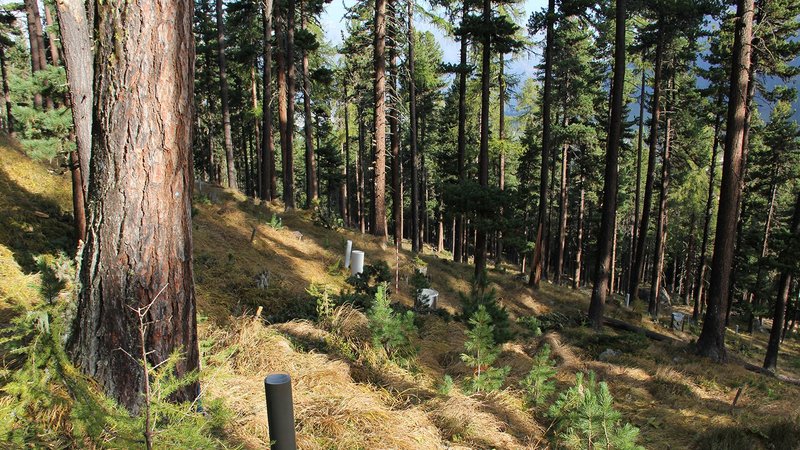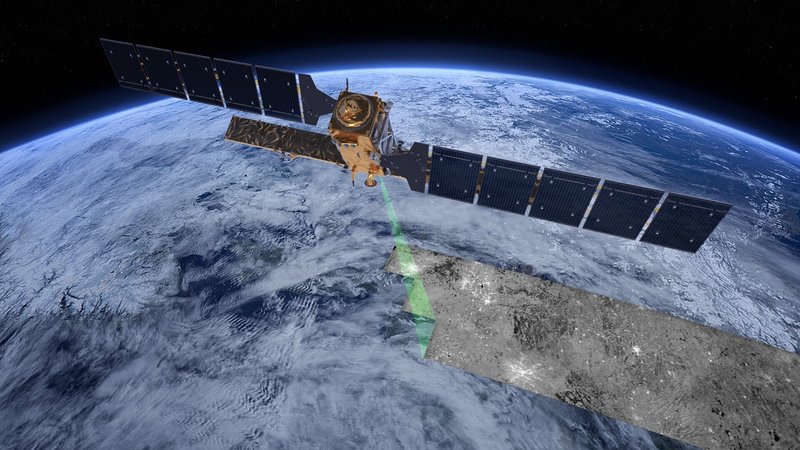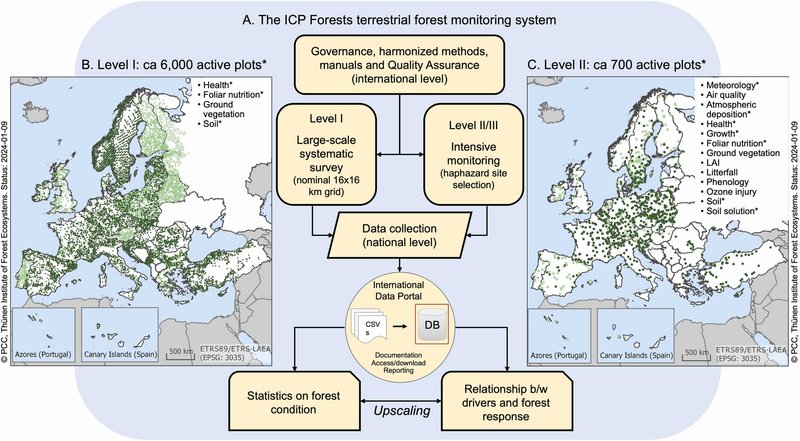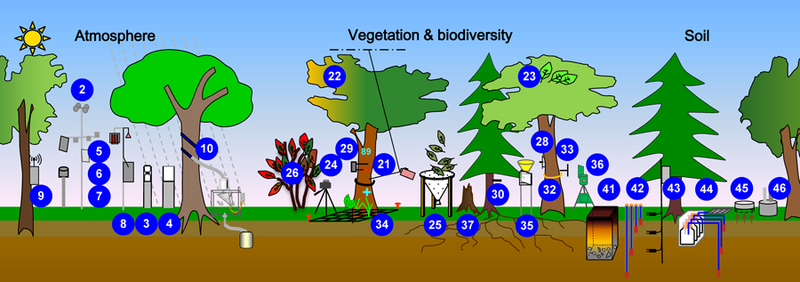
Fig. 1 Monitoring area of the Long-term Forest Ecosystem Research LWF programme of the Swiss Federal Research Institute WSL. Photo: LWF
Climate change is endangering the health of our forests to an unprecedented extent through drought stress, forest fires and pest calamities. At the same time, however, forests are expected to contribute to climate protection and provide many other ecosystem services. Forest monitoring is therefore becoming increasingly important in evaluating the effectiveness of climate protection measures and sustainable forest management. However, new information needs are challenging forest inventory and monitoring systems: they need to evolve and become more timely and comprehensive to determine future forest dynamics and ecosystem function scenarios, guide management and inform policymakers. Recently, the European Commission recognised this need and proposed a framework regulation for coordinated forest monitoring in the European Union (hereinafter referred to as the 'Proposal').
Proposal of the European Commission
The newly proposed framework for coordinated forest monitoring is based on the EU Forest Strategy 2030 and aims to improve data quality and availability across Europe and establish a coherent monitoring system. It should enable a better understanding of forest conditions and support decision-making at all levels.
The planned forest monitoring system is based on (i) standardised forest data from aerial or space-based orthoimagery from Copernicus satellites (fig. 2) or other equivalent systems provided centrally by the EU Commission and (ii) harmonised in-situ data via a network of monitoring points (national forest inventories or other networks representative of the forest area of the Member States and provided by them).

Fig. 2: Copernicus services are an interface between users and the information obtained from satellite missions and in-situ measurements. ©ESA/ATG medialab
With 227.4 million hectares (34.8 % of the land area; Source: State of Europe's Forests), forests represent an immense resource in Europe. The intention to promote their consistent monitoring is, therefore very welcome.
Critical reflection on the proposal
Existing systems
Despite the progressive approach of the European Commission's proposal, there is criticism, particularly in relation to the realistic implementation and integration of existing monitoring systems. Many countries already have sophisticated systems that provide valuable information on forest conditions. The challenge is integrating these systems into an EU-wide framework without creating redundancies or conflicts with national interests.
The most striking example is probably the monitoring system of the ICP Forests (International Co-operative Programme on Assessment and Monitoring of Air Pollution Effects on Forests), which was largely initiated by the European Commission itself in 1986. Today, the monitoring programme is financed by the participating countries as a harmonised international activity. Contrary to what is stated in the impact assessment of the proposal, forest monitoring under the ICP Forests is not only internationally coordinated, but also covers the vast majority of European countries (fig. 3).

Fig. 3: The pan-European monitoring system ICP Forests. The concept (A) is based on two differentiated monitoring levels with two networks (B: Level I; C. Level II; dark green: active areas in 2022; light green: currently inactive areas). The system works according to internationally harmonised methods for Level I and II. All methods are available at http://icp-forests.net/page/icp-forests-manual The field data is validated at the national and later at the central level, used for reporting and made available on request.
The European Commission's stated intention to "minimise the extent to which Member States need to adapt their data collection methods" seems elusive when the proposal de facto ignores the extensive structures and resources already in place in each country. These structures include national coordination centres, networks of monitoring plots (see fig. 1), expertise in different monitoring areas, manuals with harmonised methods covering all forest ecosystem compartments, data control routines and standardised data reporting formats and procedures.
Required data
The European Commission's proposal emphasises carbon sequestration in forests and is largely concerned with trees and wood resources. Little is planned, for example, in relation to the health and vitality of forests, a key aspect when considering the resilience of forests.
The health of forests depends on many different factors. Nevertheless, the proposal only mentions ‘defoliation’. The proposal envisages using the remotely sensed Leaf Area Index (LAI) for this purpose. However, this parameter cannot serve as an adequate measure of needle and leaf loss if it is not validated and calibrated on the ground. In the national forest inventories (NFI), the only ground-based monitoring systems explicitly mentioned in the proposal, data on defoliation is not routinely collected. Thus, there is a risk that forest health will be only inadequately described.
In contrast, needle/leaf loss is the key characteristic for ICP Forests and has been analysed on an annual basis for decades in both Level I and Level II networks (see fig. 3 - details in the original article). The approximately 7000 ICP Forests plots with 30-year time series are an important existing basis for the assessment of forest health in space and time. In this context, the remote sensing data proposed by the European Commission could be used for spatio-temporal modelling purposes based on ground-based observations rather than as unvalidated, stand-alone measurements.
Biodiversity is another focus of the proposal. Specific data on tree species composition and abundance, deadwood and forest birds are requested. The presence of invasive plant and tree species, the diversity of non-tree vegetation and endangered species are also mentioned, but with few methodological details and subject to the future development of monitoring.
However, there are already recognised, internationally agreed methods for monitoring the diversity of plants and animals (e.g. ground vegetation, epiphytic lichens). Others have been widely and successfully tested at European level (e.g. mycorrhiza) or are currently being developed and trialled using the ICP Forests Plot infrastructure (e.g. metabarcoding for biodiversity in soil and water samples and in insect traps).
The Long-term Forest Ecosystem Research LWF programme of the Swiss Federal Research Institute WSL investigates how air pollution and climate change affect forests. The long-term data series date back to 1994 (LWF corresponds to the ICP Forests Level II areas) and 1985 (Sanasilva inventory, corresponds to Level I). The LWF programme generates around 25 million measurement values every year. Switzerland participates in international research programmes such as ICP Forests or the LTER-Europe network (Long-Term Ecosystem Research in Europe) through the statutory tasks of the LWF programme. The Swiss Federal Research Institute WSL also runs the Swiss National Forest Inventory (NFI) since the 1980s. The NFI is mainly based on a systematic sample inventory and provides data and findings on forest area, stock, increment, felling, biodiversity, protection forest quality and socio-cultural services of the forests. It also informs international climate and forest reporting (e.g., greenhouse gas inventory, State of Europe's Forests). WSL is, as part of the SwissAIM initiative, developing concepts to improve cooperation between LWF and NFI.
Required data quality
Data comparability, quality and availability are regarded as strategic objectives in the European Commission's proposal. But how is this to be achieved? It is particularly problematic that the responsibility for data quality is left to the Member States. This could lead to major national differences. There are already many multidisciplinary harmonisation activities that have been carried out internationally within the framework of the NFI and ICP Forests and that can be easily used.
Concept
The European Commission's proposal emphasises that it is based on the latest scientific findings. However, it remains unclear what is meant by this. For example, the combination of remote sensing and terrestrial data has been practised since decades. Why does the European Commission not draw on the wealth of international monitoring networks and research infrastructures that have been developed during this time? Some examples for such existing networks are:
ICP Forests, ICP Integrated Monitoring, eLTER, ICOS
With their vast data archives, these networks would make an invaluable contribution, particularly regarding the 'process understanding' part of monitoring, an essential missing component in the European Commission's proposal. This omission is not only surprising because it detracts from the proposal's ability to achieve its stated objectives. It is also surprising given that the EU (i) has played a key role in establishing and funding these existing systems, (ii) is a signatory to the UNECE Air Convention, and (iii) is investing in projects designed to promote future monitoring and where various communities (including NFIs, ICP Forests and remote sensing) are already collaborating. Examples for such projects are:
HORIZON EUROPE PathFinder, FORWARDS, MoniFun, COST Action CLEANFOREST
What is the next step?
In order to achieve the goal of comprehensive and coherent forest monitoring, existing resources and monitoring networks should be utilised and strengthened through integrative approaches (such as the SwissAIM initiative). This includes the promotion of co-operation between Member States and the use of international networks. Such an approach could improve the effectiveness of monitoring while minimising the burden on national systems. Specifically:
- The monitoring concept should be revised and further developed by utilising existing internationally coordinated networks in order to reduce the burden on Member States and achieve the European Commission's objectives.
- Synergies between existing monitoring networks should be identified and utilised (with any gaps to be filled) to enable Europe-wide monitoring.
- An institutional framework for a co-operative, integrated forest monitoring system should be developed to facilitate co-operation between existing networks and to strengthen the role of the EU and international institutions.
Summary
Climate change will significantly alter forests and pose major challenges for forest management. A European Commission proposal for a new forest monitoring programme aims to improve data quality and availability. In order to accurately assess the state of forests and predict future developments, more precise data is needed than national programmes can provide, and data from ground-based monitoring programmes must be combined with remote observation data. Experts recommend involving existing international monitoring networks more closely and creating an institutional framework for cooperation. This would increase the effectiveness of monitoring and reduce the burden on national systems. Conceptual adjustments are necessary to achieve the objectives of the proposal and to ensure the sustainable management and protection of European forests.
Literature
Detailed source and literature references can be found in the scientific publication on which this article is based:
Ferretti M., Gessler A., Cools N., Fleck S., Guerrieri R., Jakovljević T., … Sanders T.G.M. (2024) Resilient forests need joint forces for better inventorying and monitoring. For. Ecol. Manag. 561, 121875 (6 pp.).
> doi.org/10.1016/j.foreco.2024.121875
> Original article (PDF)


